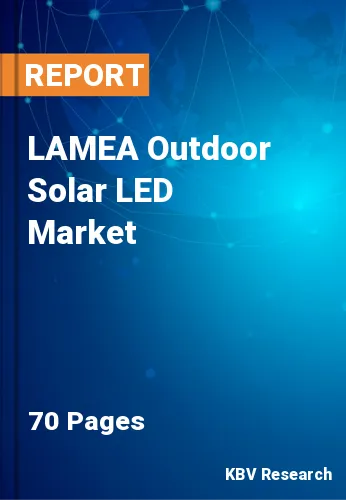The Latin America, Middle East and Africa Outdoor Solar LED Market would witness market growth of 25.6% CAGR during the forecast period (2022-2028).
The photovoltaic technology, which permits the solar cell to transform sunlight into useful electrical energy, is used in solar LED street lighting. When negatively-charged ions push solar energy into positively-charged regions in the cells, it is transformed. Solar energy is transferred into electrons through this process, resulting in direct current electricity. To transport the new direct current electricity generated by the solar cell, wires from the solar cell are linked to the battery. When night falls, the solar cell will turn off the conversion process because sunlight is no longer available. When there isn't enough sunlight to convert, photoreceptors assist in shutting down the solar cell.
The battery would start sending electricity to the LED bulb via cabling at this point. Solar LED street lights may be used in any environment, making them excellent for locations with limited power. A solar LED street light's portability and environmental responsibility makes it an attractive replacement for traditional street lights and a viable solution for locations without or restricted access to an electricity grid.
The United Arab Emirates (UAE) has one of the highest rates of solar exposure in the world, which means it has a lot of room for renewable energy development. The country has long depended on conventional energy sources despite having large indigenous oil and gas reserves. However, in order to prevent the dramatic commodities downturns linked with an oil-based economy, a push for economic diversification has resulted in new incentives and the introduction of cutting-edge renewable energy technologies. Furthermore, rapid industrialization, population growth, and increased demand from desalination facilities have resulted in higher energy demands and a need to diversify inputs.
As a result, the UAE has been at the forefront of the MENA region's renewable energy development. The following milestones reflect this: the establishment of the Abu Dhabi Future Energy Company, Masdar, and the region's first carbon-neutral zero waste city, Masdar City, in 2006; the planning to host the annual World Future Energy Summit in Abu Dhabi in 2008; the formation of the Emirates Nuclear Energy Corporation (ENEC) in 2009; the International Renewable Energy Agency (IRENA) naming Abu Dhabi as its headquarters in 2009 and relocating to Masdar City ca. 2010; the establishment of the Emirates Nuclear Energy Corporation.
The Brazil market dominated the LAMEA Outdoor Solar LED Market by Country in 2021, and would continue to be a dominant market till 2028; thereby, achieving a market value of $380.1 million by 2028. The Argentina market is poised to grow at a CAGR of 26.3% during (2022 - 2028). Additionally, The UAE market would display a CAGR of 25.2% during (2022 - 2028).
Based on Application, the market is segmented into Street Lights, Garden Lights, Floodlights, Area Lights, and Spot Lights. Based on End Use, the market is segmented into Commercial, Residential, and Industrial. Based on Wattage, the market is segmented into 40W to 149W, Less than 39W, and More than 150W. Based on countries, the market is segmented into Brazil, Argentina, UAE, Saudi Arabia, South Africa, Nigeria, and Rest of LAMEA.
Free Valuable Insights: The Global Outdoor Solar LED Market is Predict to reach $19.8 Billion by 2028, at a CAGR of 23.5%
The market research report covers the analysis of key stake holders of the market. Key companies profiled in the report include Greenshine New Energy LLC, Jiawei Renewable Energy Co. Ltd., Leadsun, SBM NewTech Co., Ltd., Solar Electric Power Company, Signify N.V., Jiangsu Sokoyo Solar Lighting Co., Ltd., Solar Street Lights USA, and Sunna Design SA.
By Application
By End Use
By Wattage
By Country
Our team of dedicated experts can provide you with attractive expansion opportunities for your business.

